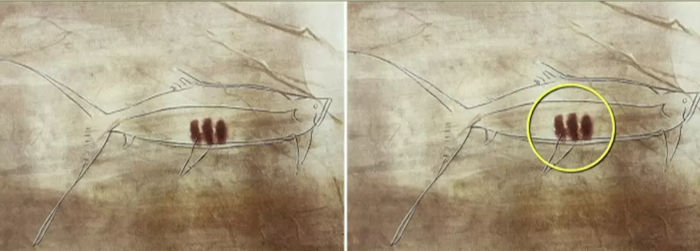Cryptic Ice Age Markings In European Caves Deciphered – Proto-Writing Discovered By Amateur Archaeologist
Conny Waters – MessageToEagle.com – Mysterious ancient dots and stripes on European cave paintings have puzzled scientists for decades. It has been suggested these markings made by Ice Age hunter-gatherers contained a hidden meaning, but it was impossible to decipher them.
Ben Bacon spent years studying Ice Age cave art and found a proto-writing. Credit: Durham University /PA
London-based furniture conservator Ben Bacon, an amateur archaeologist, spent years examining famous cave paintings at Lascaux and Altamir and over 600 other sites. Bacon determined the secret behind the Ice Age dots and the distinctive Y symbol in the cave paintings.
Working together with academics from Durham University, Bacon decoded the meaning of markings seen in Ice Age drawings and, in doing so, found evidence of early writing dating back at least 14,000 years earlier than previously thought.
Sophisticated Information Sharing Invented By Ice Age Hunter-Gatherers
The study reveals that Ice Age hunter-gatherers were using markings such as lines and dots, combined with drawings of their animal prey, to record and share sophisticated information about the behavior of these animals, at least 20,000 years ago.
Dots like these from 23,000 years ago helped Ice Age hunter-gatherers survive. Henri Breuli/Durham University/PA Wire
Until now, archaeologists have known that these sequences of lines, dots, and other marks – found on cave walls and portable objects from the last Ice Age were storing some kind of information but did not know their specific meaning.
By using the birth cycles of equivalent animals today as a reference point, the team could determine that the number of marks associated with Ice Age animals were a record, by lunar month, of when they were mating.
The team also ascertained that a ‘Y’ sign in the markings – formed by adding a diverging line to another – stood for ‘giving birth’.
Their work demonstrates that these sequences record mating and birthing seasons and found a statistically significant correlation between the number of marks, the position of the ‘Y’ sign, and the months in which modern animals’ mate and give birth, respectively.
Proto-Writing
As the marks, found in over 600 Ice Age images on cave walls and portable objects across Europe, record information numerically and reference a calendar rather than recording speech, they cannot be called ‘writing’ in the sense of the pictographic and cuneiform, or wedge-shaped, systems of early writing that emerged in Sumer from 3,400 BC onwards.
These hand stencils and wild horses were created about 30,000 years ago. Credit: Neanderthal Museum/Durham University/PA
Instead, the team refers to them as a proto-writing system, pre-dating other token-based systems that are thought to have emerged during the Near Eastern Neolithic by at least 10,000 years.
Visual palaeopsychology
The study, published in the Cambridge Archaeological Journal, was led by an independent researcher, Ben Bacon, and involved a small team including Durham Professors Paul Pettitt (Department of Archaeology) and Robert Kentridge (Department of Psychology).
Dots and other markings were used to record animals’ reproductive cycles. Credit: Berenguer, M/Durham University/PA
Horse drawn onto the wall of Niaux Cave (Ariège, France) around 15,000 years ago. Credit: Neanderthal Museum/Durham University/PA
Professors Pettitt and Kentridge have worked together to develop the field of visual palaeopsychology, the scientific investigation of the psychology that underpins the earliest development of human visual culture and drew on their collaborative skills to analyze the team’s data.
These drawings and markings were made 15,000 years ago. Credit: Neanderthal Museum/Durham University/PA
The study not only decodes information first recorded thousands of years ago but also shows that Ice Age hunter-gatherers were the first to use a systematic calendar and marks to record information about major ecological events within that calendar.
See also: More Archaeology News
Having demonstrated that they can crack the meaning of at least some of these symbols, the team hopes to continue their work and attempt to understand more of the symbols, their cognitive bases, and what information Ice Age hunter-gatherers valued.
Written by Conny Waters – MessageToEagle.com – AncientPages.com Staff Writer
















